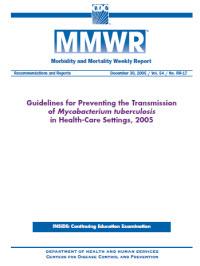This report discusses the guidelines set forth by the United States (US) Department of Health and Human Services to prevent and control the spread of tuberculosis (TB) in various types of health care facilities. The report examines the epidemiology of TB in the US, as well as the pathogenesis of TB infection to active TB. It explains the risks for the nosocomial transmission of TB, and the fundamentals of TB infection control in health-care facilities. It provides guidelines about how to perform a TB risk assessment for the health-care facility and about how to develop a good infection control plan. It summarizes how to identify, evaluate, and initiate treatment for patients suspected of having active TB. The report states how to care and manage patients with TB in different types of health-care facilities. The report tells the reader about the engineering controls necessary to keep TB from spreading in health-care facilities and training for health care workers (HCW). The report reviews how to diagnose and treat patients with TB infection and active TB, including preventive therapy for latent TB infection. The report provides guidelines for engineering controls and respiratory protections in health care facilities.
- Infection Control and Occupational Health Workers
- TB
- Infection Control


